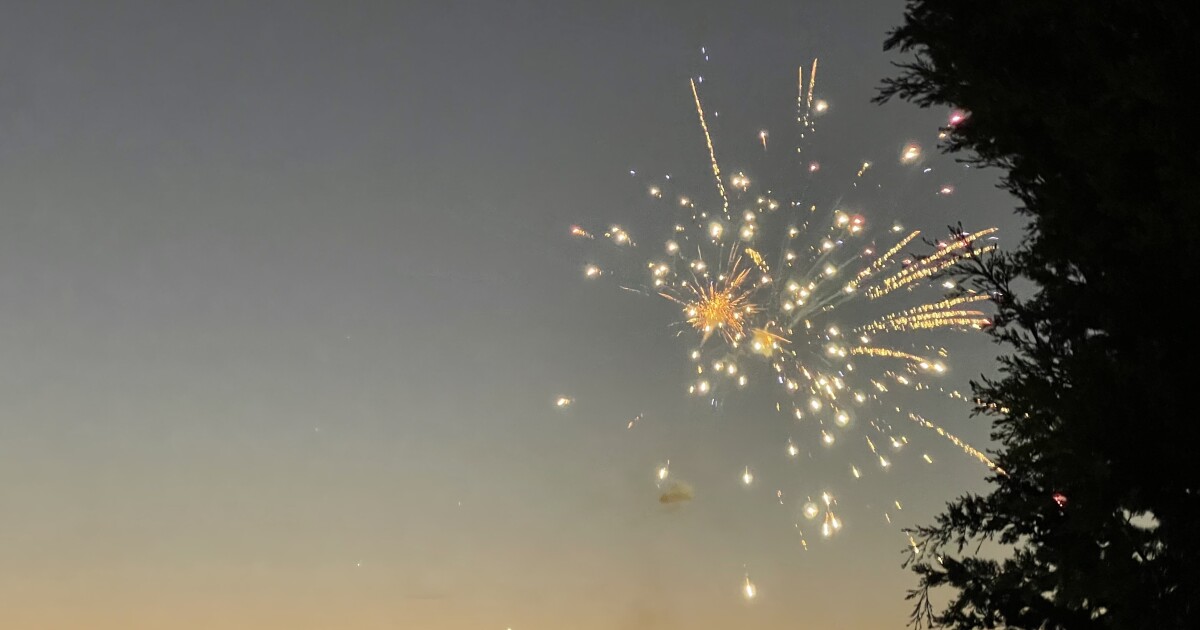Keep up with LAist.
If you’re enjoying this article, you’ll love our daily newsletter, The LA Report. Each weekday, catch up on the 5 most pressing stories to start your morning in 3 minutes or less.
Fireworks on the Fourth of July bring a uniquely abrasive spirit of festivity to Southern California — along with terrible air pollution. Nearly every year, the region experiences its most hazardous air quality on July 4 and 5, even in areas that don’t put on their own pyrotechnics shows.
When Fourth of July fireworks are over, what is LA breathing?
So what exactly lingers in the air after all those oohs and ahhs? What are we breathing?
As with most things that explode, fireworks emit a lot of particulate matter — a mixture of tiny particles suspended in the air.
With fireworks, the ingredients of that particulate matter are metals that produce blasts or colors, said Scott Epstein, air quality assessment manager at the South Coast Air Quality Management District.
“ Some of those metals are actually toxic to breathe,” he added.
The AQMD, which monitors and regulates pollution in Southern California, lists the metals that can help create different colors: strontium (pinks, oranges and purples); magnesium (silvers); barium (greens).
Some illegal fireworks also contain lead.
“The range of unknowns of what’s in there is something people should think about when they make their choices,” said Will Barrett, senior director for nationwide clean air advocacy with the American Lung Association.
But beyond the possibility that the pollution could be toxic, fireworks release high levels of fine particle pollution in the air. In fact, Epstein said the amount of pollution is “ nearly the highest that we see all year.”
This fine particle pollution, which you may have heard about in terms such as “PM 2.5” or “PM 10,” which indicates the size of the particle, can get deep into the lung and cause health issues.
“ Usually anything 2.5 microns or less is what gets really deep into the lungs,” said Dr. Isabel Pedraza, associate professor of medicine at Cedars-Sinai hospital in L.A.
Ingesting these particles can cause dangerous inflammation in the lungs and blood vessels.
This often causes symptoms you can feel immediately, such as decreased lung capacity, coughing and worsening asthma. But it can also increase the risk of heart attacks, strokes and arrhythmias.
Pedraza runs a clinic that primarily treats patients with asthma and COPD. She said the pollution from fireworks exacerbates symptoms of lung disease.
“ After fireworks is always a bit of a busy time,” she said.
She also explained that children will feel the effects more acutely. They tend to have a higher respiratory rate, so they may be breathing in more pollutants. But also: “ They’re smaller, and so it takes less concentration to have an effect,” Pedraza said.
How to protect yourself as much as possible
So what to do?
Lower your exposure, every expert said.
Specifically, Epstein highlighted “ staying inside, keeping your windows and doors closed, running an air purifier or your HVAC fan,” to help keep your indoor space clear of pollution.
The pollution often lingers the night of the Fourth, especially if winds aren’t dispersing the pollution.
“ It just sits around, gets trapped by our mountains, gets trapped in kind of the lowest levels of the atmosphere,” Epstein said.
Backyard fireworks may also increase emissions closer to the ground where you’re breathing.
Depending on the wind, areas farther from original sites of the fireworks can be affected as well.
“This stuff can be carried in the air, sometimes miles away, depending on what the wind speed is,” Pedraza said.
This can be a risk not only to those with preexisting health conditions, but also to elderly people, children or outdoor workers.
If you have to be outside, an N95 mask may offer some, though not complete, protection, experts said.
If not fireworks, what?
There are alternatives. Several Southern California cities are putting on drone shows for reasons that include varying from air pollution and fire safety concerns.
But even experts on pollution and lung health differed on how to weigh health risks against the sense of camaraderie and awe inspired by rockets’ red glare on Independence Day.
“ I’m originally from Boston,” Pedraza said, “and they have one of the best fireworks displays every year that I’ve ever seen.”
Barrett also acknowledged the unique sense of celebration that fireworks can bring, but highlighted the possibility that drones and lasers could replace that.
“That can give you the really amazing family moments, the holiday moments where fireworks have been used — and do it without the heavy dose of pollution,” he said.
Regardless, fireworks celebrations will be happening across Southern California. At the very least, you can be aware of the air pollution from maps produced by AQMD and others.
Epstein warned, though, that backyard or illegal fireworks may create “localized hotspots” of pollution. A neighborhood surrounding that area may have higher concentrations of pollution that may not be captured by a region-wide map.
